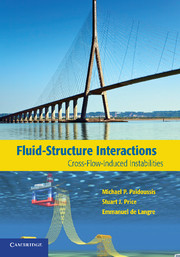Book contents
- Frontmatter
- Contents
- Preface
- 1 Introduction
- 2 Prisms in Cross-Flow – Galloping
- 3 Vortex-Induced Vibrations
- 4 Wake-Induced Instabilities of Pairs and Small Groups of Cylinders
- 5 Fluidelastic Instabilities in Cylinder Arrays
- 6 Ovalling Instabilities of Shells in Cross-Flow
- 7 Rain-and-Wind-Induced Vibrations
- Epilogue
- Appendix A The Multiple Scales Method
- Appendix B Measurement of Modal Damping for the Shells Used in Ovalling Experiments
- References
- Index
7 - Rain-and-Wind-Induced Vibrations
Published online by Cambridge University Press: 04 February 2011
- Frontmatter
- Contents
- Preface
- 1 Introduction
- 2 Prisms in Cross-Flow – Galloping
- 3 Vortex-Induced Vibrations
- 4 Wake-Induced Instabilities of Pairs and Small Groups of Cylinders
- 5 Fluidelastic Instabilities in Cylinder Arrays
- 6 Ovalling Instabilities of Shells in Cross-Flow
- 7 Rain-and-Wind-Induced Vibrations
- Epilogue
- Appendix A The Multiple Scales Method
- Appendix B Measurement of Modal Damping for the Shells Used in Ovalling Experiments
- References
- Index
Summary
Of all cross-flow induced instabilities, rain-and-wind-induced vibrations, referred to as RWIV, are a special case. They have been identified quite recently and are certainly a challenge to understand. For the purposes of this book, they somehow gather together several of the issues that have been presented: hence, they deserve some treatment, even if the relentless evolution of knowledge on the subject makes any review soon obsolete.
Experimental Evidence
Field cases
This surprising case of cross-flow-induced motion was identified in the 1970s on cables of cable-stayed bridges. First reported by Wianecki (1979), it was described in detail by Hikami & Shiraishi (1988) as follows. Large-amplitude motion of some cables occurred in the presence of wind with rain but disappeared when the rain stopped. This is illustrated in Figure 7.1, where the existence of motion of the cables, as recorded in situ, is clearly correlated to the occurrence of rain. Similar occurrences have been reported in various bridges over the years; see for instance Ruscheweyh & Verwiebe (1995), Matsumoto et al. (1989), Zuo et al. (2008), Ni et al. (2007) and Main & Jones (1999). Although the cables undergoing such vibrations differed from one bridge to another, some common features were identified. First, the motion was specific to the concurrent existence of significant rain and wind, but it stopped if the wind velocity exceeded some value.
- Type
- Chapter
- Information
- Fluid-Structure InteractionsCross-Flow-Induced Instabilities, pp. 345 - 356Publisher: Cambridge University PressPrint publication year: 2010



